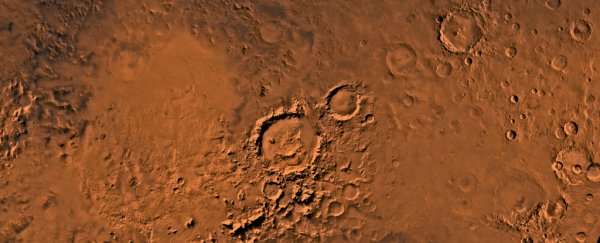If we want to find evidence of life - either past or present - on Mars, our best bet is to search an enormous basin in the Red Planet's southern hemisphere, known as the Argyre basin, according to a new study.
A team of astrobiologists have investigated the best places for future missions to target, and found that the basin is rich with all the ingredients necessary for the evolution of life - in other words, if it happened anywhere on the Red Planet, then it's very likely to have happened there.
"Argyre displays a collection of landscape features that are promising from an astrobiological point of view, including hydrothermal deposits, pingos [mounds of dirt-covered ice fed by water] or ancient glacier deposits," lead researcher Alberto Fairén, from Cornell University told Nola Taylor Redd over at Space.com.
Even better, the position and structure of the 1,770-km (1,100-mile) wide basin make it pretty easy for us to explore, so it's the ideal destination for future missions hoping to seek out evidence that life might once have existed on Mars. "This large collection of special features all together in the same setting, accessible by a single mission, is what makes Argyre unique," said Fairén.
So what makes the Argyre basin so special? At one point, Mars had an atmosphere that protected it from radiation and lots of flowing water, two features which could have made the planet habitable to certain lifeforms.
That was around 4 billion years ago, which is around the same time a rock smashed into the Red Planet, forming the Argyre basin, which researchers think could have contained a giant body of water that fed nearby rivers. The impact could have also triggered hydrothermal activity near the basin, which might have helped to trigger or feed life.
Gradually, Mars' atmosphere was stripped away by harsh solar winds, and the planet froze and dried up, making it the far less hospitable place we've now come to know and love thanks to our recent rover missions.
But billions of years ago, not only would the Argyre basin have been a great place for life to originate and/or thrive, it also would have been a fantastic place for fossils to be preserved - so even if life no longer exists on the Red Planet, we might still be able to find some traces of it there.
The Argyre basin lies about 50 degrees south in latitude - roughly equivalent to the position of the Falkland Islands here on Earth, TechTimes reports. And sunlight is very hard to come by in the winter months, which means that any landers going to check out the potential for life would probably need to be nuclear-powered, not solar-powered.
Fairén and his team suggest first using orbiters to monitor the region closely from above, before landing rovers with mini science labs and drilling equipments on board, to search for any signs of life.
"I would like to have a true life-searching payload to inspect the astrobiologically promising features," Fairén told Space.com. "Argyre could be safeguarding the latest remains of an ancient Martian biosphere."
Knowing this, why don't we just send Curiosity on over to check the region out? Well, it turns out rovers are a whole lot dirtier than you'd think - or, at least, they have the potential to be. And that means they could also contaminate samples collected on the Red Planet with lifeforms from Earth, giving us false positives.
And if Curiosity was properly sterilised, it would fry its electronics, so we'll have to find a way to properly sterilise a new rover to send over there.
Or if we get desperate, maybe we can just wait for the first Mars settlers to check the basin out themselves, because in around 15 years, NASA is hoping to send humans to the Red Planet. It's pretty crazy to imagine space pioneers searching for fossils in the basin of a distant plant, but that's the beauty of science - you never know where you'll end up.
The new study has been published in Astrobiology.
